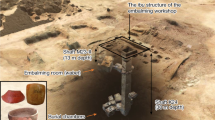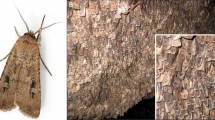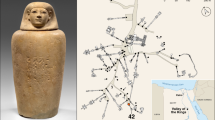Abstract
Chemical treatments were an essential element of ancient Egyptian mummification. Although the inorganic salt natron is recognized as having a central role as a desiccant1, without the application of organic preservatives the bodies would have decomposed in the humid environment of the tombs2. The nature of the organic treatments remains obscure, because the ancient Egyptians left no written record of the process. Secondary textual evidence for mummification is provided by Herodotus3, Diodorus Siculus4, Strabo5 and Pliny6. The most important account is that of Herodotus3 (about 450 yr bc), although archaeological evidence shows that by this time the process had declined significantly and the best results had been achieved centuries before7. His account mentions myrrh, cassia, palm wine, ‘cedar oil’ (still widely disputed8,9,10) and ‘gum’; however, it is vague with respect to the specific natural products used. Here we report the results of chemical investigations of a substantial collection of samples of tissues, wrappings and ‘resinous/bituminous’ materials from provenanced and dated Egyptian mummies. We focused on examples of the ‘classic’ mummy-making culture of the Pharaonic or dynastic period, from which we can begin to track the development of mummification chronologically.
This is a preview of subscription content, access via your institution
Access options
Subscribe to this journal
Receive 51 print issues and online access
$199.00 per year
only $3.90 per issue
Buy this article
- Purchase on Springer Link
- Instant access to full article PDF
Prices may be subject to local taxes which are calculated during checkout




Similar content being viewed by others
References
Sandison, A. T. The use of natron in mummification in ancient Egypt. J. Near Eastern Studies 22, 259–267 (1963).
Hunter, J., Roberts, C. & Martin, A. in Studies in Crime: An Introduction to Forensic Archaeology 63–78 (Batsford, London, 1996).
Herodotus The Histories (trans. De Sélincourt, A.) Book II, 160–161 (Penguin, Harmondsworth, 1954).
Diodorus Siculus The Library of History (trans. Oldfather, C. H.) (Heinemann, London, 1935).
Strabo The Geography (trans. Jones, H. L.) (Heinemann, London, 1932).
Pliny (the Elder) Natural History (trans. Rackham, H.) (Heinemann, London, 1968).
Smith, G. E. & Dawson, W. R. Egyptian Mummies (Allen & Unwin, London, 1924).
Baumann, B. B. The botanical aspects of ancient Egyptian embalming. Econ. Bot. 14, 84–104 (1960).
Lucas, A. “Cedar”-tree products employed in mummification. J. Egypt. Archaeol. XVII, 13–21 (1931).
Mendelsohn, S. The mortuary crafts of ancient Egypt. CIBA Symposia 1795–1804 (1944).
Lucas, A. A preliminary note on some preservative materials used by the ancient Egyptians in connection with embalming. Cairo Sci. J. II, 133–147 (1908).
Spielmann, P. E. To what extent did the ancient Egyptians employ bitumen for embalmimg? J. Egypt. Archaeol. XVIII, 177–180 (1932).
Zaki, A. & Iskander, Z. Materials and methods used for mummifying the body of Amentefnekht, Saqqara 1941. Ann. Serv. Antiquites Egypte XLII, 223–255 (1943).
Rullkötter, J. & Nissenbaum, A. Dead Sea asphalt in Egyptian mummies: molecular evidence. Naturwissenschaften 75, 618–621 (1988).
Colombini, M. P., Modugno, F., Silvano, F. & Onor, M. Characterization of the balm of an Egyptian mummy from the seventh century B.C. Stud. Conserv. 45, 19–29 (2000).
Koller, J., Baumer U., Kaup Y., Etspüler, H. & Weser, U. Embalming was used in Old Kingdom. Nature 391, 343–344 (1998).
Buckley, S. A., Stott, A. W. & Evershed, R. P. Studies of organic residues from ancient Egyptian mummies using high temperature-gas chromatography-mass spectrometry and sequential thermal desorption-gas chromatography-mass spectrometry and pyrolysis-gas chromatography-mass spectrometry. Analyst 124, 443–452 (1999).
Mills, J. S. & White, R. The Organic Chemistry of Museum Objects 2nd edn (Butterworth-Heinemann, Oxford, 1994).
Raven, M. J. Wax in Egyptian magic and symbolism. Oudheidkundige Mededeelingen uit het Rijksmuseum van Oudheden te Leiden 64, 7–47 (1983).
van der Doelen, G. A., van den Berg, K. J. & Boon, J. J. Comparative chromatographic and mass spectrometric studies of triterpenoid varnishes: fresh material and aged samples from paintings. Stud. Conserv. 43, 249–264 (1998).
Serpico, M. & White, R. in Ancient Egyptian Materials and Technology (eds Nicholson, P. T. & Shaw, I.) 430–474 (Cambridge Univ. Press, Cambridge, 2000).
Barber, M. S., McConnell, V. S. & DeCaux, B. S. Antimicrobial intermediates of the general phenylpropanoid and lignin specific pathways. Phytochemistry 54, 53–56 (2000).
Bahn, P. G. The making of a mummy. Nature 356, 109 (1992).
Connan, J. & Dessort, D. Du bitume dans des baumes de momies égyptiennes (1295 av. J.-C. -300 ap. J.-C.): détermination de son origine et evaluation de sa quantité. C. R. Acad. Sci. Paris II 312, 1445–1452 (1991).
Granville, A. B. An essay on Egyptian mummies, with observations on the art of embalming amongst the ancient Egyptians. Phil. Trans. R. Soc. Lond. 115, 269–316 (1825).
Acknowledgements
We thank S. Giles of Bristol Museum; J. Spencer and J. Taylor of the British Museum; J. Hayward of Liverpool Museum; R. David of Manchester Museum; and K. Eremin of the National Museum of Scotland for making the samples available to us. We thank J. Fletcher for advice on aspects of Egyptology; and J. Carter and A. Gledhill for technical assistance. NERC provided financial support for mass spectrometry facilities.
Author information
Authors and Affiliations
Rights and permissions
About this article
Cite this article
Buckley, S., Evershed, R. Organic chemistry of embalming agents in Pharaonic and Graeco-Roman mummies. Nature 413, 837–841 (2001). https://doi.org/10.1038/35101588
Received:
Accepted:
Issue Date:
DOI: https://doi.org/10.1038/35101588
This article is cited by
-
Evolution of orthopaedic diseases through four thousand three hundred years: from ancient Egypt with virtual examinations of mummies to the twenty-first century
International Orthopaedics (2024)
-
Biomolecular analyses enable new insights into ancient Egyptian embalming
Nature (2023)
-
Biomolecular characterization of 3500-year-old ancient Egyptian mummification balms from the Valley of the Kings
Scientific Reports (2023)
-
Analysis of Organic Residue in a Wooden Vessel Excavated from a Tomb of Japanese Samurai Buried in the Seventeenth Century
International Journal of Historical Archaeology (2023)
-
Reshaping Egyptian funerary ritual in colonized Nubia? Organic characterization of unguents from mortuary contexts of the New Kingdom (c. 1550–1070 BCE)
Archaeological and Anthropological Sciences (2023)
Comments
By submitting a comment you agree to abide by our Terms and Community Guidelines. If you find something abusive or that does not comply with our terms or guidelines please flag it as inappropriate.



